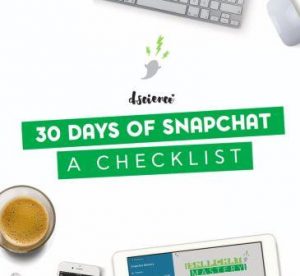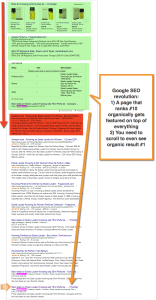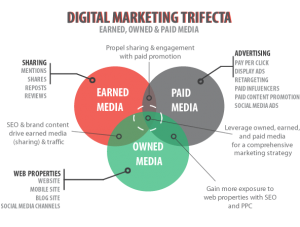If you love someone, set them free. If they come back they’re yours; if they don’t they never were, the saying goes.
In other words, if you want sustainable and long-term results you have to bank on trust, mutual benefit and added value. You need to create an emotional bond in order to make people come back to you. The thing is – you can’t bond with a machine. You can bond with living creatures only. So why would you focus on search engine optimization, if what really matters to you are your users? Even better – users matter to search engines too. So what should you do?
1. Switch Goals
Don’t aim at a #1 ranking position but excellent user experience instead. In the end, Google’s SERPs reflect popularity of a website but they don’t necessarily ignite it – the user does. If users love a website, Google will do so too. Take an Ex-Googler’s word for it. So in order to get on top of search results you need to provide the user with an extraordinary experience.
Imagine your website being an amusement park in which case the first and foremost goal is to amuse your visitors. Now, would it help you to be on each and every cover page nationwide? At first glance, it might. But then again, if you can’t live up to your promise, one hell of a buzz is all you’ll get before it becomes really quiet around you. Thus, all placement and marketing in the world won’t provide sustainable results, if you can’t deliver when it really matters – namely when the user and your product or services finally meet. The user experience provided here will make the difference. All of the techniques described below come as a result of this fundamental change of perspective.
2. Rethink Keywords
Take off your SEO glasses and look at your keyword set from a user’s perspective. Search volume and competition may be important indicators for the popularity of a keyword, but they don’t tell anything about search intent. However, users will only click through to your article and stay on the site, if your content fulfills their intention of search. Were they seeking for further information or was their search driven by the intent to buy and convert?
It’s crucial to differentiate between the various objectives and necessities in order to offer the user exactly what he or she needs and wants. Your success will be measured in user behaviour data which then again will impact your rankings in the long run. So it’s not just about getting ranked number one for a specific keyword. This ranking won’t last long and won’t drive any conversions, if you can’t satisfy your users’ demands and expectations linked to that very keyword later on-site.

Where to Start:
Type each of your keywords into Google. Take a closer look at the Top 10 in SERPs to identify search intent. Google tries to rank the most relevant aka most-clicked and approved page for this keyword. So, it seems safe to assume that the top-ranking websites fit user intent pretty well. Then check the content you’ve created for this keyword and find out how to make it fit even better.
3. Stop Link Building
Links are the result of effective user experience marketing so put emphasis on interpersonal relations and added value.
No one knows, if rankings or high-quality links come first, however, both come as a consequence of optimized usability. Every link has to enrich the user experience. Therefore, it needs to be contextually relevant leading to high-quality content that provides the user with added value.
Leverage the symbiosis of SEO, content marketing, and online PR to reach that goal. As hard as you try you can’t make people like you. But you can earn their trust providing relevant information and being authentic to at least make it much harder for them not to like you in the end. Consider your backlinks, your business cards, and place and treat them as such to leave a positively memorable first impression with the user. If you mess up the first encounter, you probably won’t get another chance.

Where to Start:
Conduct a backlink audit for your website. Check relevancy, quality and authority of existing backlinks and disavow low-quality links. After the clean-up start implementing a well-thought content marketing strategy to earn sustainable links via content. Build up a CRM and foster relationships to influencers and multipliers in your specific industry. This will help you to effectively leverage the symbiosis of content marketing and online PR for generating top notch backlinks.
4. Humanize Snippets
Do away with keyword optimization in snippets to better focus on what makes the user click. Plugins like Yoast evaluate your snippets with regard to SEO but user behaviour data like click-through-rate (CTR) have much higher impact on ranking positions. Search engines like Google aim at providing the best possible search experience so they naturally take user behaviour into consideration. The best-researched keywords and most creative implementation in your snippet can’t make up for a missing click-through-rate. You thus need to raise interest and curiosity in the reader to make them click. In the second step you need, of course, to cater to this interest and curiosity on your website. It’s not enough to just trick people into entering your restaurant you need to serve them a delicious meal as well or you’ll never see them again. This is why dwelling time also impacts your ranking.

Where to Start:
Scan through your snippets and ask yourself, if you’d click on them. Do they communicate benefit for the potential reader? Are they straight to the point? Can the linked content live up to the expectations raised in the meta description? Resist the temptation to fall for click baiting techniques. Instead craft unique and compelling snippets for each and every page on your site.
5. Prioritize Branding
SEO doesn’t allow you to build a brand and yet a strong brand has many positive effects on visibility in organic search.
A brand is an emotionally charged concept that needs to appeal to human beings in order to increase identification and thus loyalty in the customer. A brand with many happy and loyal customers will be very popular as well because recommendation marketing and word-of-mouth are still two of the most powerful leverages in marketing. Since – as said in the beginning – popularity will be reflected in Google SERPs a strong brand achieves better rankings in return.
This is why it makes sense to push branding forward, create an appealing brand image and communicate it effectively to your target group. There are many ways to build a strong brand. However, its fundamentals always are authenticity, consistency, and honesty. You need to create moments of magic for your users and enchant them with your one of a kind charisma.

Coca-Cola is the perfect example for a strong brand that doesn’t even need to put its name on their products anymore to be recognized.
Where to Start:
Picture your brand as a real character. What kind of personality does it have? How does it approach other people? Who does your brand hang out with and how does it dress? What kind of language does it use? Of course, the answers will have symbolic character only. But it will be much easier to define your brand image if you give it a face. A strong brand is much more than just a company name. It’s the feeling that rises in employees, customers and prospects at the sound of this name.
Wrapping Up
Since its inception SEO has changed a lot. As a technical discipline in the beginning, it was very prone to loopholes and consequently misuse. Today SEO has become more of a positive effect triggered by user-centered measures. The system certainly isn’t impeccable yet but with the user at its core it’s much more target-aimed and rewarding than it was when we were still focusing on complying with search engines’ requirements only. Back then it was more of a showdown between Google and SEOs, whilst today in the best case both are working towards the same goal: user satisfaction that helps everyone involved to get the most out of web search and Internet usage.
Digital & Social Articles on Business 2 Community(131)






